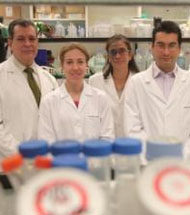La cardiotrofina-1 está implicada en la supervivencia celular ante la hipoxia
Los resultados de este estudio se han publicado en el número de noviembre de Cardiovascular Research

Los niveles de cardiotrofina CT-1, una proteína esencial en el desarrollo del corazón, se elevan en los cardiomiocitos expuestos a hipoxia. Además, esta proteína está implicada en el proceso de supervivencia de los cardiomiocitos en respuesta al estrés hipóxico.
Uno de los principales hallazgos de este trabajo es que se ha identificado el factor de transcripción inducible por hipoxia-1 (HIF-1) como el responsable de esta respuesta celular compensatoria, ya que induce la expresión de la proteína CT-1 ante la falta de oxígeno. "Comprobamos que la hipoxia propiciaba un aumento de los niveles de proteína CT-1, que se reducía al inhibir el factor HIF-1, e identificamos al detalle el mecanismo de regulación transcripcional. Pero lo más interesante fue comprobar que el silenciamiento de CT-1 aumentaba la muerte celular", explica el Dr. Guillermo Zalba, investigador principal del Laboratorio de Enfermedad Vascular Hipertensiva.
